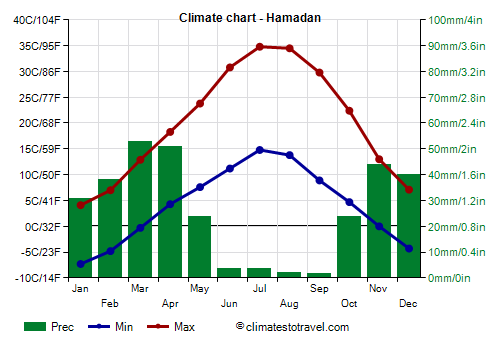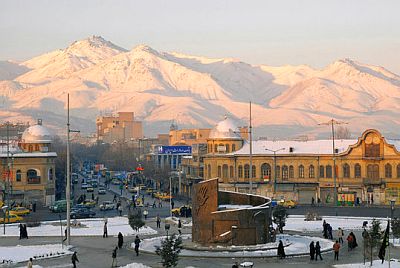Select units of measurement for the temperature and rainfall tables (metric or imperial).
Average weather, temperature, rainfall, sunshine hours

Hamadan (ancient Ecbatana) is a city of 554,000 inhabitants located in northwestern Iran, at almost 35 degrees north latitude and 1,850 meters (6,050 feet) above sea level. Just south of the city is Mount Alvand, 3,580 meters (11,745 ft) high, part of the Zagros Mountains.
Hamadan's climate is
arid continental, with cold winters and hot, sunny summers.
 Winter
Winter, from December to February, is cold, with a daily average around freezing. Fog can form during periods of stable weather.
Given the low temperatures, snowfalls are quite frequent, although generally not abundant, given the low level of precipitation. During cold spells, the temperature can drop to -25 °C (-13 °F) or below. Due to its quite northern location and altitude, Hamadan is one of the coldest cities in Iran. The coldest record is -34 °C (-29 °F), set in January 1964. In January 2008, the temperature dropped to -31 °C (-24 °F), and the daily average for the month was -11.2 °C (11.8 °F).
Spring, from March to May, is a variable season, with temperature changes and gusts of wind. Furthermore, it is the rainiest season, also due to the thunderstorms that break out in April and May.
Summer, from June to August, is hot and sunny, however, due to the altitude, nights are generally cool, and the humidity is not high. However, heat waves are possible, with peaks of 38/40 °C (100/104 °F).
Hamadan - Climate data
In Hamadan, the
average temperature of the coldest month (January) is of
-1.6 °C, that of the warmest month (July) is of
24.8 °C. Here are the average temperatures.
Hamadan - Average temperatures (1991-2020) |
| Month | Min | Max | Mean |
|---|
| January | -7.3 | 4.1 | -1.6 |
|---|
| February | -4.8 | 7 | 1.1 |
|---|
| March | -0.3 | 12.9 | 6.3 |
|---|
| April | 4.3 | 18.3 | 11.3 |
|---|
| May | 7.6 | 23.8 | 15.7 |
|---|
| June | 11.2 | 30.8 | 21 |
|---|
| July | 14.8 | 34.8 | 24.8 |
|---|
| August | 13.8 | 34.5 | 24.2 |
|---|
| September | 8.9 | 29.8 | 19.4 |
|---|
| October | 4.7 | 22.4 | 13.6 |
|---|
| November | 0 | 13 | 6.5 |
|---|
| December | -4.3 | 7.1 | 1.4 |
|---|
| Year | 4.1 | 19.9 | 12 |
|---|
amounts to
315 millimeters per year: it is therefore scarce. It ranges from
1.5 millimeters in the driest month (September) to
53 millimeters in the wettest one (March). Here is the average precipitation.
Hamadan - Average precipitation| Month | Days |
|---|
| January | 31 | 6 |
|---|
| February | 38 | 6 |
|---|
| March | 53 | 7 |
|---|
| April | 51 | 7 |
|---|
| May | 24 | 4 |
|---|
| June | 4 | 1 |
|---|
| July | 4 | 1 |
|---|
| August | 2 | 0 |
|---|
| September | 2 | 0 |
|---|
| October | 24 | 3 |
|---|
| November | 44 | 6 |
|---|
| December | 40 | 6 |
|---|
| Year | 315 | 49 |
|---|
There are on average around 3025
sunshine hours per year. Here are the average hours of sunshine per day.
Hamadan - Sunshine hours| Month | Average | Total |
|---|
| January | 5 | 160 |
|---|
| February | 6.5 | 180 |
|---|
| March | 7 | 215 |
|---|
| April | 8 | 235 |
|---|
| May | 9.5 | 295 |
|---|
| June | 12 | 355 |
|---|
| July | 11 | 345 |
|---|
| August | 11 | 340 |
|---|
| September | 10.5 | 315 |
|---|
| October | 8.5 | 260 |
|---|
| November | 6 | 175 |
|---|
| December | 5 | 155 |
|---|
| Year | 8.3 | 3025 |
|---|